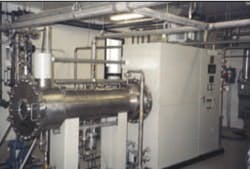The water superintendent in Winfield, Kan., used to receive hundreds of taste and odor complaints from his drinking water customers. However, these numbers have significantly dropped since the 2004 installation of an ozone system as the primary disinfection technique for his 6 million gal per day (mgd) surface water treatment plant (SWTP). The superintendent also noted dramatic reduction of total tri-halo methane compounds (TTHM) from compliance levels to nearly undetectable, and lowering of compliance levels of halo-acetic acids (HAA5) by an additional 80%, while eliminating the need for carbon feeding.
Finding a solution
It was Dan Defore, water superintendent for the City of Winfield, who first noticed that previous treatment techniques for taste and odor control had stopped working.
The city tried a number of tactics, such as moving feed rates up from 10-15 ppm to 25-30 ppm, and as high as 40 ppm of carbon. Defore also tried a temporary addition of potassium permanganate, or hydrogen peroxide, but nothing seemed to fix the problem.
Defore noted that the number of complaints concerning the water system, which serves about 13,000, reached the hundreds from December 2002 to January 2003. Therefore, when it was time to renovate the plant, odor and taste was an important issue.
The ozone fix
Professional Engineering Consultants, P.A. of Wichita, Kan., designed the plant with Bruce Allman as project engineer and Kevin Rood as project manager.
“Winfield not only had a taste and odor issue, but also some organics-related color, so we were looking for a technology that could perform oxidation treatment as well,” Rood said. “In addition, we were concerned about the state’s Surface Water Treatment Rule that was already implemented when we started planning in 2002. We knew there would be an issue of future disinfection of Cryptosporidium to unknown concentration levels, and we wanted the city to be ready with a treatment method already in place.”
The city also needed to reduce TTHMs and HAA5s. Defore did not want to try chlorine dioxide because of the operators’ lack of confidence in the reliability of the generators and byproducts. At this point ozone came into consideration.
“We were very encouraged by the City of Emporia’s (Kan.) 10 years of experience with it [the ozone system], in a much larger plant than ours,” Defore said. “We decided to put it in not just to solve the taste and odor problem, which could have been a predisinfection treatment, but to serve as our primary disinfection system.”
Originally commissioned in 1969, the SWTP is fed through a 24-in. line by a 1,200-acre lake that is nine miles from the plant. It has solid contact basins for coagulation and sedimentation, and a dual-media filtering system. In addition to establishing ozone as the primary disinfection system, the 2004 renovation included change-out of the filter media; addition of domes over the basins; new chemical feed equipment; and air scour to aid in the filter backwash process.
The system
In considering ozone system vendors, Defore had noted a major distinction among them. “The vendor we chose for the ozone had a very competitive price, but more importantly, we expected the best possible service from a company that was trying hard at the time to get established in the U.S. And they were also guaranteeing the dielectric and other key parts for 10 years, which was twice as long as the other vendors.”
Defore also reports that the company visited every six months within the service contract to help develop ongoing preventive maintenance. In addition, Defore noted that not much happened between visits that couldn’t be fixed over the telephone.
To help assure continuous delivery of ozone for disinfection, the ozone generators feature patented, self-healing dielectric tubes designed to allow for continued operation of the dielectric surface during failure of a segment. The generators were manufactured by Mitsubishi Electric Corp. of Kobe, Japan, with system design, installation, and ongoing service provided by its subsidiary, Mitsubishi Electric Power Products Inc. of Warrendale, Pa.
“Since we installed the ozone system in 2004, there have been very few taste and odor complaints about our product,” said Defore. “Meanwhile, we’ve also reduced our TTHM levels—which are regulated at 80 ppb max—from around 60 ppb to nearly undetectable amounts, and our HAA5s— which are regulated at 60 ppb limit—from about 45 ppb to less than 8 ppb.”
Clifford Seth is the editor in chief of Indumark. He can be reached at 215-348-5105 or by email at [email protected].


